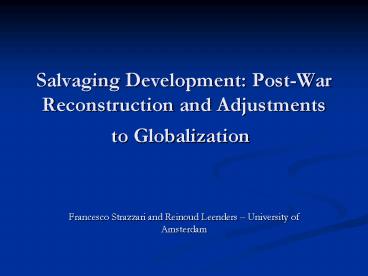Salvaging Development: PostWar Reconstruction and Adjustments to Globalization - PowerPoint PPT Presentation
1 / 11
Title:
Salvaging Development: PostWar Reconstruction and Adjustments to Globalization
Description:
Salvaging Development: Post-War Reconstruction and Adjustments to Globalization ... policies, privatization & fiscal austerity, education and health sector ... – PowerPoint PPT presentation
Number of Views:50
Avg rating:3.0/5.0
Title: Salvaging Development: PostWar Reconstruction and Adjustments to Globalization
1
Salvaging Development Post-War Reconstruction
and Adjustments to Globalization
- Francesco Strazzari and Reinoud Leenders
University of Amsterdam
2
The World Bank in War and Post-War
Reconstruction
- World Bank Post-Conflict Unit 1997
- Colliers Economics of Civil War, Crime and
Violence, 1999 - World Bank, Breaking the Conflict Trap Civil War
and Development Policy, 2003. - Paul Collier and Nicholas Sambanis (eds),
Understanding Civil War, The World Bank, 2005 (2
volumes).
3
Collier-Hoeffler Model for Civil War Onset
- Not political social grievance per se leads to
civil war, but, rather, for given levels of
grievance, it is the opportunity to organize and
finance a rebellion that determines if a civil
war will occur or not. The determinants of such
opportunity are mainly economic greed.
4
World Bank in post-war reconstruction
- Post-Conflict Fund, 1998
- International donor trust funds including
Afghanistan, Kosovo, East Timor, Palestine, Iraq.
5
Main Arguments
- The WBs interest and specialization in the
economics of war and post-war reconstruction and
indeed the interest in general by aid
practitionersclosely relate to the general
demise of development both as a
sub-disciplinary study and a policy
apparatussince the 1990s. - The WBs interest in post-war reconstruction can
be seen as an attempt at revival or reform of
development and the external policy
interventions prompted by it. - The WB leaves intact the very flaws of
development that underlie this notions
intellectual bankruptcy and lack of credibility
as an effective policy tool Development is
reinvented not reconsidered.
6
Moral and Strategic Imperatives
- ..the international community has the moral
right and the practical duty to intervene to
prevent and shorten conflicts. - - Breaking the Conflict Trap
7
The CH-model on Globalization Civil War
- Countries at higher risk of civil war are the
least globalized as measured in terms of these
countries openness to foreign trade and FDI. - As globalization again measured in terms of
foreign trade and FDIis viewed as fostering
economic growth, a strong correlation between
economic growth and political stability rules
that, indirectly, globalization counters civil
wars. - It follows that policy should encourage
globalization as preventive and a remedy to civil
war.
8
Post-War Reconstruction Repeating Developments
Flaws
- Spurious precision on the meaning of
globalization formal versus informal economies
9
Post-War Reconstruction Repeating Developments
Flaws A-historical, de-contextualized
- Three global resources going into rebels and
militias - extortion of natural resources
- Donations from diasporas
- Nature primary commodity exports and dependence
on these.
10
Post-War Reconstruction Repeating Developments
Flaws A-historical, de-contextualized
- Global opportunities, not causes
- International management and regulation financial
markets. - Curbing illegal trade in drugs, arms and natural
resources. - Cushioning international financial and economic
volatility
11
Development, Aid Conflict
- Aid can reinforce, exacerbate and prolong
conflict because when international assistance is
given in the context of a violent conflict, it
becomes a part of that context and thus also of
the conflict. (Anderson, Do No Harm. How Aid Can
Support Peace or War, 1999) - Development aid industry in pre-1994 Rwanda
contributed to violence by bolstering patterns of
exclusion (material and racism, oppression) and
state actors benefiting from them without for a
single moment reconsidering its own role to this
effect. (Peter Uvin, Aiding Violence the
Development Enterprise in Rwanda, 2000) - IFIs own policies may have contributed to civil
wars e.g. Sierra Leone, Serbia and Rwanda SAP
and macro-economic stability policies,
privatization fiscal austerity, education and
health sector reform, financial shock 1998 Asian
Crisis. - Capitalist development creative destruction
greed































